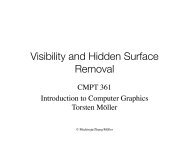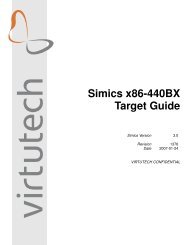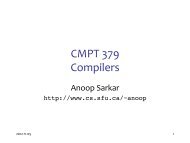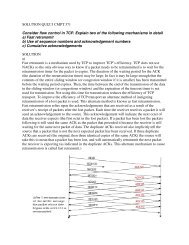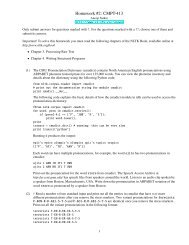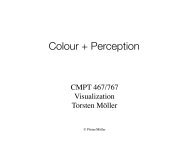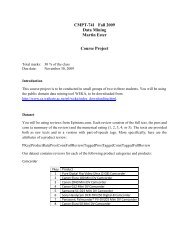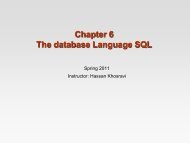Assignment 4
Assignment 4
Assignment 4
Create successful ePaper yourself
Turn your PDF publications into a flip-book with our unique Google optimized e-Paper software.
CMPT 310 - Artificial Intelligence Survey<br />
<strong>Assignment</strong> 4<br />
Due date: Friday, April 12, 2013<br />
J.P. Delgrande<br />
10 marks March 25, 2013<br />
Important Note: Students must work individually on this, and other CMPT 310, assignments.<br />
You may not discuss the specific questions in this assignment, nor their solutions<br />
with any other student. You may not provide or use any solution, in whole or in part, to or<br />
by another student.<br />
You are encouraged to discuss the general concepts involved in the questions in the context<br />
of completely different problems. If you are in doubt as to what constitutes acceptable<br />
discussion, please ask!<br />
1. (5 marks) Consider the following example:<br />
Aching elbows and aching hands may be the result of arthritis. Arthritis is<br />
also a possible cause of tennis elbow, which in turn may cause aching elbows.<br />
Dishpan hands may also cause aching hands.<br />
(a) Represent these facts in a belief network. Let ar stand for “arthritis”, ah for<br />
“aching hands”, ae for “aching elbow”, te for “tennis elbow”, and dh for “dishpan<br />
hands”.<br />
(b) Suppose the following probabilities are given:<br />
P r(ar) = .001 P r(dh) = .01<br />
P r(ah|ar, dh) = P r(ae|ar, te) = .1<br />
P r(ah|ar, ¬dh) = P r(ae|ar, ¬te) = .99<br />
P r(ah|¬ar, dh) = P r(ae|¬ar, te) = .99<br />
P r(ah|¬ar, ¬dh) = P r(ae|¬ar, ¬te) = .00001<br />
P r(te|ar) = .0001 P r(te|¬ar) = .01<br />
Assume that we are interested in determining whether it is more likely that a<br />
patient has arthritis, tennis elbow, or dishpan hands.<br />
i. With no observations at all, which of the three is most likely a priori?<br />
ii. If we observe that the patient has aching elbows, which is now the most likely?<br />
iii. If we observe that the patient has both aching hands and elbows, which is<br />
the most likely?<br />
1
iv. How would your rankings change if there were no causal connection between<br />
tennis elbow and arthritis, where for example<br />
P r(te|ar) = P r(te|¬ar) = .0099<br />
instead of the two values given above?<br />
Please show all of hyour calculations for full marks.<br />
2. (5 marks) Consider an electronics outfit that wants to figure out hom much time to<br />
spend with a customer. Relevant attributes are the person’s age, income, whether they<br />
are a student or not, and their credit rating. The target attribute is whether they will<br />
buy something. You are given the following training data.<br />
Id Age Income Student Rating Purchase<br />
1 < 25 high no ok no<br />
2 < 25 high no good no<br />
3 25 . . . 40 high no ok yes<br />
4 > 40 med no ok yes<br />
5 > 40 low yes ok yes<br />
6 > 40 low yes good no<br />
7 25 . . . 40 low yes good yes<br />
8 < 25 med no ok no<br />
9 < 25 low yes ok yes<br />
10 > 40 med yes ok yes<br />
11 < 25 med yes good yes<br />
12 25 . . . 40 med no good yes<br />
13 25 . . . 40 high yes ok yes<br />
14 > 40 med no good no<br />
The goal is to predict whether a customer will make a purchase, based on the other<br />
attributes.<br />
Construct the optimal decision tree that corresponds to this data. Please show and<br />
explain all steps.<br />
2



